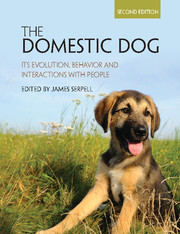Book contents
- Frontmatter
- Dedication
- Contents
- List of contributors
- 1 Introduction
- PART I ORIGINS AND EVOLUTION
- PART II BEHAVIOR, COGNITION AND TRAINING
- PART III DOG-HUMAN INTERACTIONS
- PART IV LIFE ON THE MARGINS
- 16 Variation in dog society: Between resource dispersion and social fl ux
- 17 The ecology and behavior of feral dogs: A case study from central Italy
- 18 Roaming free in the rural idyll: Dogs and their connections with wildlife
- 19 Dog population management
- 20 Epilogue: The tail of the dog
- Index
- Plate section
- References
18 - Roaming free in the rural idyll: Dogs and their connections with wildlife
from PART IV - LIFE ON THE MARGINS
Published online by Cambridge University Press: 30 December 2016
- Frontmatter
- Dedication
- Contents
- List of contributors
- 1 Introduction
- PART I ORIGINS AND EVOLUTION
- PART II BEHAVIOR, COGNITION AND TRAINING
- PART III DOG-HUMAN INTERACTIONS
- PART IV LIFE ON THE MARGINS
- 16 Variation in dog society: Between resource dispersion and social fl ux
- 17 The ecology and behavior of feral dogs: A case study from central Italy
- 18 Roaming free in the rural idyll: Dogs and their connections with wildlife
- 19 Dog population management
- 20 Epilogue: The tail of the dog
- Index
- Plate section
- References
Summary
Introduction
Since the domestication of the wolf (Canis lupus), some 13 000–17 000 years ago, dogs (Canis familiaris) have become close companions to humans, and been integrated into communities, families and folklore (Driscoll & MacDonald, 2010). During that time the dog population has extended, along with humans, across every continent except mainland Antarctica, until there are now an estimated 700 million of them worldwide (Hughes & MacDonald, 2013). Today the roles of dogs in human society are complex and varied: from status symbols kept in handbags to dogs raised with the livestock they are trained to protect; from sacred icons to sources of income for breeders or racers; from waste disposers to family members, with each role resulting in different levels of integration with the human community (see Serpell, Chapter 15). The benefits of domesticated dogs to communities and human society are manifold but there are also costs to this symbiosis. It is undoubtedly true that dogs cause problems for humans – they are, for example, the most common source of rabies in the world, the cause of 99% of the 55 000 human fatalities globally (Knobel et al., 2005) – and a sizeable economic cost may be incurred due to the injuries they cause (e.g. estimated $620 million a year in the US; Pimentel et al., 2005). There are also costs for the dogs who may suffer from high mortality, malnutrition, disease, parasitism, starvation and abuse (Pal, 2001; Sowemimo, 2009). Indeed, where dogs are identified as a source of public health problems, governing bodies may be prompted to eradicate them in a variety of ways with attendant welfare concerns (Dalla Villa et al., 2010), whilst owners may abandon or destroy puppies and adults they cannot afford (Hsu et al., 2003).
Alongside these costs – and our focus in this chapter – are the problems this domestic carnivore may cause within the environments to which they are introduced, and for the wildlife species with which they interact (Hughes & MacDonald, 2013; Young et al., 2011). While wildlife does exist within urban areas, it is arguable that the majority of interactions of conservation relevance between wildlife and dogs take place in rural regions, where dogs may move between human-dominated areas and the surrounding landscape (MacDonald & Carr, Chapter 16).
- Type
- Chapter
- Information
- The Domestic DogIts Evolution, Behavior and Interactions with People, pp. 369 - 384Publisher: Cambridge University PressPrint publication year: 2016
References
- 3
- Cited by

